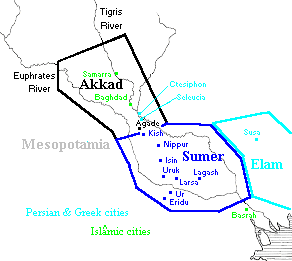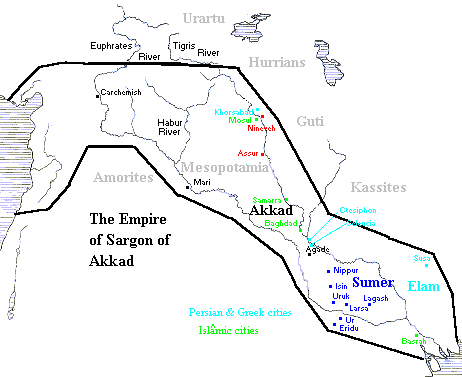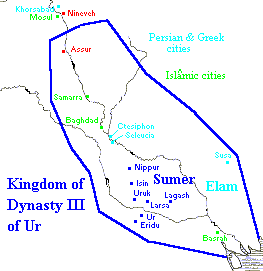| |
Sumer and
Sumerians, Kings of Sumer and Akkad

Mesopotamia produced one of the best-known
ancient civilizations, with a literate, urban culture and highly-developed
political institutions. Sumer and the Sumerians are those who contributed to
the extraordinary social and technological developments in the Mesopotamia
region from 3800 to 2000 BC.
A book by Samuel Noah Kramer is titled
History Begins at Sumer [Doubleday Anchor, 1959]. This is true, but, as with early
Egyptian history, it is a vague and frustrating kind of history, and one without the succession of hard monuments that become the signposts of time in Egypt. Sumeria was also politically fragmented into city states -- none with the concentrated power that enabled
Khufu to make sure that he would never be forgotten. Here dynasties are given for Kish,
Uruk, Ur, and Lagash. The early history of all these cities is mythologized in later documents. Thus,
Gilgamesh might be regarded as a purely legendary figure if he did not also occur in the ordinary king lists. There is also some trouble, as in Egypt, reading the names. The obscurity of early Sumer is compounded by later misconceptions. The Biblical expression, "Ur of the
Chaldees," although used by the great excavator of Ur, C. Leonard Woolley, for the title of a book about the city (Norton Library, 1965), is extremely anachronistic and misleading. Ur was originally a city of the Sumerians, not of the
Chaldeans. The latter were actually Aramaeans, who did not appear in Mesopotamia until nearly a thousand years after the end of the Sumerians as a distinct linguistic community. The Chaldeans dominated Mesopotamia in the "Neo-Babylonian" Period, not only long after the Sumerians but also long after any reasonable date for Abraham -- if Abraham came from "Ur of the
Chaldees," this must be a different Ur, already Aramaean in Abraham's day, or it is just applying an anarchronistic epithet to a city that
later was associated with the
Chaldeans. The Sumerian language itself was neither Semitic nor Indo-European, a representative of a now vanished pre-historic language family that may have also included the
Elamite, Kassite, Hurrian, and Urartuan languages. Since unaffiliated languages still exist nearby in the
Caucasus (e.g. Georgian), it is always possible that they were all related.


History begins at Sumer because the Sumerians were undoubtedly the first to have a functioning system of writing. The origins of this are now plausibly explained by Denise Schmandt-Besserat (cf.
Before Writing, Volume I, From Counting to Cuneiform, University of Texas Press, 1992). For purposes of accounting, contracts, shipping, etc., little clay models were made of the kinds of commodities involved. For convenience, these models were then placed in clay wrappers. Then, so that the contents of the wrappers could be known without breaking them, little drawings of the models began to put on the wrappers. Soon it became obvious that the little drawings by themselves made the models superfluous.
The stylization of the models had already produced a certain abstraction and stylization in the drawings, which thus became proto-cuneiform -- a system already pre-adapted to representing numbers as well as concepts. Since thousands of the clay models have been found, the evidence for the process is abundant. No such antecedents have been found in
Egypt or India, where writing began soon after the Sumerian precedent. It is hard not to conclude that Sumerian influence, with the evidence of Sumerian artifacts to prove it, sparked the development of writing in those places. Where writing developed independently elsewhere, i.e
China and the New World, Middle Eastern influence via Central Asia cannot be discounted on the former, while Mayan glyphs, only recently deciphered at all, had not progressed far, even three thousand years later, beyond the most basic versions of cuneiform or hieroglyphics. Nor were even the Aztecs still using the system at that level, while the Incas had no form of writing whatsoever. The achievement of the Sumerians thus represents a unique and pivotal moment in human history.

On the other hand, the Sumerians were also doomed by history. The first chill came from the Semitic speakers, the
Akkadians, who lived immediately north of them. Sargon of Akkad built the first Middle Eastern Empire, at the time of the Egyptian
VI Dynasty, embracing all of Sumeria and extending far up the Tigris and Euphrates rivers. Sargon's name,
Sharru-kîn, means "the king is legitimate," an almost sure sign that he wasn't -- the story of his royal birth but childhood among commoners is similar to the story of Moses in the Bible or of Karn.a in the
Mahâbhârata, all of whom said they had been set adrift as infants and claimed a status opposite from what they started with.
| Dynasty of Akkad |
| Sharru-kîn, Sargon |
2334-2279 |
| Rimush |
2278-2270 |
| Manishtusu |
2269-2255 |
| Narâm-Sîn |
2254-2218 |
| Shar-kalli-sharri |
2217-2193 |
[interregnum,
Guti invasion, c.2193]
|
| Shu-Turul |
2168-2154 |
One of Sargon's successors also had a significant name: Shar- kalli- sharri means "king of all kings." Shortened to just "king of kings," this became a standard title for later Assyrian and then Persian monarchs. It even survived in Modern Persian as
Shâhanshâh.
An invasion of the Guti, a non-Semitic people in the Zagros, disrupted the Akkadian state and led to its downfall.
| Dynasty IV of Uruk |
| Ur-nigina |
2153-2147 |
| Ur-gigira |
2146-2141 |
| [3 kings] |
2141-2124 |
| Dynasty V of Uruk |
| Utu-hegal |
2223-2113 |
| Dynasty III of Ur |
| Ur-Nammu |
2112-2095,
revised
2018- |
| Shulgi |
2094-2047,
revised
-1953 |
| Amar-Sîn |
2046-2038 |
| Shu-Sîn |
2037-2029 |
| Amorites appear, c.2034 |
| Ibbi-Sîn |
2028-2004,
revised
-1911 |
| Elamites sack Ur, c.2004 |
| Lagash |
| Ur-Baba |
2155-2142 |
| Gudea |
2141-2122 |
| Ur-Ningirsu |
2121-2118 |
| Pirig-me |
2117-2115 |
| Ur-gar |
2114 |
| Nam-mahazi |
2113-2111 |
Governors of
Lagash for Ur |
| Ur-Ninsuna |
|
| Ur-Ninkimara |
|
| Lu-kirilaza |
|
| Ir-Nanna |
-2023 |
Sargon's empire, however, did not long survive this ambitiously named king, and it was followed by a Sumerian revival. The III Dynasty of Ur was the last brilliant moment for the Sumerians, ruling the whole country as none of the earlier dynasties had. But the set of the tide was already obvious:
The last three kings of Ur III already have names incorporating the Akkadian name of the moon god,
Sîn, rather than the Sumerian name, Nanna. Sumer was being linguistically overwhelmed. But not forgotten. Sumerian civilization did not vanish, it was simply translated; but even the translators did not forget Sumerian -- it was remembered by scholars, even by Kings of Assyria, centuries after it had last been uttered in ordinary speech. Babylon and Assyria became the heirs of it all. But we are too. The process of translation continued, since our own days of the
week are translations, through Latin and Greek, of the Babylonian and ultimately Sumerian names of the planets.
 The list and dates here are from Georges Roux,
Ancient Iraq [Penguin, 1966 edition and revised 1992 edition], pp. 502-504. However, it now appears that Roux's dates are about 94 years too early. In "Astronomy and the Fall of Babylon," in the July 2000
Sky & Telescope [pp.40-45], Vahe G. Gurzadyan discusses changes that can be made in Babylonian chronology on the basis of analysis of Babylonian astronomical records (the
Enûma Anu Enlil) and more accurate modern calculations of ancient eclipses. Three revised dates are given above for Ur III. A key event for this period was a lunar eclipse on 27 June 1954 BC, which was thought at the time to have foretold the death of King Shulgi of Ur.
Kelley L. Ross,
Ph.D.
|
|






